6 Central Asia and Caucasus
The Central Asian and Caucasus region is located in a geopolitically important place linking East Asia, South Asia, the Middle East, Europe, and Russia. Its development and stability hold great significance for those of the Eurasian region as a whole. The region is also strategically important for its abundant natural resources such as oil, natural gas, uranium, and rare earths. At the same time, the region is geopolitically vulnerable to the influence of major countries in its vicinity, as well as to the public security situations of neighboring countries.
Central Asian and Caucasus countries have worked toward transitioning to a market economy and economic development since their independence in 1991. However, they still face issues such as aging economic infrastructure established during the former Soviet Union era, human resources development for the transition to a market economy, and the building of social systems including health and medical care. In addition, the sanctions against Russia related to its aggression against Ukraine in 2022 have affected the countries economically and socially, including logistical restrictions, and they are under pressure to deal with such a situation.
Japan provides cooperation toward the free, open, and sustainable development of the Central Asian and Caucasus region.
● Japan’s Efforts
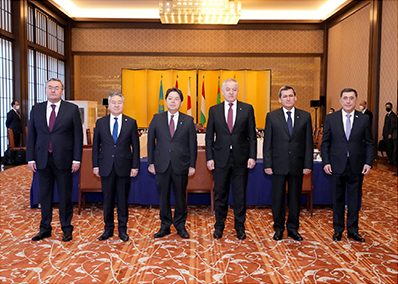
The 9th Foreign Ministers’ Meeting of the “Central Asia plus Japan” Dialogue (December 2022)
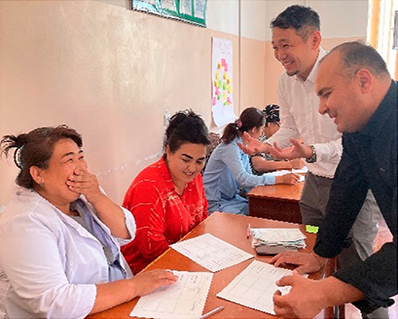
Uzbekistan nurses exchanging ideas with a Japanese expert about how to provide effective nutrition education in their communities (Photo: JICA)
Japan provides assistance for Central Asian and Caucasus countries in diverse fields such as improvement of infrastructure, human resources development, and the rebuilding of basic social services including health and medical care, in order to support these countries’ efforts toward resolving the aforementioned issues.
In particular, in regard to Japan’s relationship with Central Asian countries, Japan launched the “Central Asia plus Japan” dialogue in 2004 and promotes cooperation within the region aimed at contributing to the peace and stability of Central Asia, as a partner for maintaining and strengthening the free and open international order. At the 9th Foreign Ministers’ Meeting of the “Central Asia plus Japan” Dialogue held in Tokyo in December 2022, the ministers agreed to promote cooperation along new models, with emphasis on “investment in people” and “quality of growth” in order to achieve sustainable development in the five countries in Central Asia. As for Japan’s relationship with the Caucasus countries, based on the “Caucasus Initiative” announced in 2018, Japan’s basic policy consists of two pillars of cooperation, namely (i) assistance for human resources development of architects for state building (human resources development) and (ii) assistance for paving the way to an “Appealing Caucasus” (infrastructure development and business environment improvement).
Japan has accepted approximately 12,100 trainees from Central Asian and Caucasus countries and dispatched approximately 3,300 experts to those countries by 2022 as part of its support for human resources development. Moreover, Japan provides support in the development of human resources necessary for nation-building efforts, including through the implementation of the Project for Human Resource Development Scholarship, which is a study-in-Japan program for young government officials and others, the Development Studies Program, and the development of human resources for business at the Japan Center for Human Resources Development.
In regard to basic social services, as part of its assistance for COVID-19 response, Japan provided grant aid totaling approximately 3.2 billion yen through December 2022 to eight Central Asian and Caucasus countries for the provision of health and medical equipment. From January 2022, Japan provided approximately 700,000 doses of vaccines to Tajikistan and Uzbekistan through the COVAX Facility. Note 21 In addition, Japan provided medical equipment for the diagnosis of non-communicable diseases worth approximately 1 billion yen to the Kyrgyz Republic, and medical equipment and educational materials for medicine worth approximately 800 million yen to Uzbekistan.
Furthermore, Japan has dispatched water service policy advisory experts to Tajikistan to provide training for the country-wide implementation of the volumetric tariff system for water supply service, which was established under the “Project for Strengthening the Water Service Management of Pyanj and Khamadoni Vodokanals” (see “Project Introduction Column” for details).
In addition, Japan provides support to the Central Asian region in the areas of border control, anti-drug measures, and prevention of violent extremism in light of such factors as the situation in neighboring Afghanistan.
Tajikistan
Stable Supply of Safe Water
Project for Strengthening the Water Service Management of Pyanj and Khamadoni Vodokanals
Technical Cooperation Project (April 2017 – June 2021)
In Khatlon Province, located in the southern part of Tajikistan, only approximately 47% of residents had access to safe water due to the aging water supply facilities built during the former Soviet Union era. Especially in Pyanj and Khamadoni Districts, many residents used poor quality water such as water from irrigation and shallow wells for drinking and living.
To overcome this situation, from 2008 to 2016, Japan renovated and expanded water supply facilities in both districts through grant aid. In addition, Japan had implemented this technical cooperation project since 2017 to ensure that these facilities would be properly operated and maintained. Aiming to strengthen organizational capacity and improve the management of both water and sewerage public utilities (Vodokanals/VKs) in Pyanj and Khamadoni, the project provided guidance on how to organize data required for operating water supply systems as well as operate and maintain water supply facilities.
In particular, the project succeeded in converting the fee collection system from the previous fixed-rate system to the meter-rate system advocated by the government. As a result of these efforts, a safe and stable water supply was made possible 24 hours a day. In addition, by increasing the water supplied population, the revenue of VKs increased (1.65 time increase in Pyanj), which contributed to improving their management significantly. This was the first time that a meter-rate system was introduced in Khatlon Province, and the fee collection system that applies Japanese knowledge and systems was established as the “Pyanj/Khamadoni Districts model.” The model is expected to be further promoted and expanded.
Tajikistan is actively involved in the water sector in the international community. In June 2022, Tajikistan and the UN jointly held an international conference Note 1 in the capital Dushanbe, while Tajikistan, together with the Netherlands, will co-chair a UN conference Note 2 in New York in March 2023. At the June 2022 meeting, the achievements of this project were shared, and then Parliamentary Vice-Minister for Foreign Affairs Honda reported on the “Kumamoto Initiative for Water” at the Fourth Asia-Pacific Water Summit Note 3 held in Japan. Through this project, Japan and Tajikistan deepen mutual cooperation in the water sector and demonstrate their presence in international initiatives.
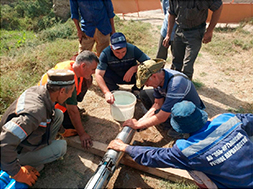
A JICA expert conducting operation and management training for well pumps for engineers of the local VKs (Photo: JICA)
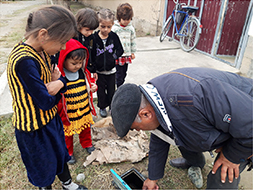
A meter reader reading a water meter newly installed through the introduction of the meter-rate system (Photo: JICA)
Note 1: Second High-Level International Conference on the International Decade for Action, “Water for Sustainable Development.”
Note 2: 2023 Conference for the Midterm Comprehensive Review of Implementation of the UN Decade for Action on Water and Sanitation (2018-2028).
Note 3: See “ODA Topics.”
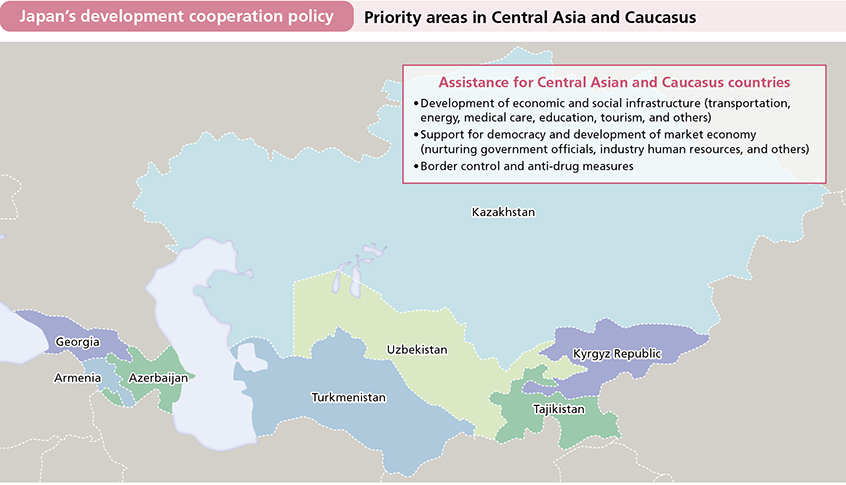
- Note 21: See the glossary.
